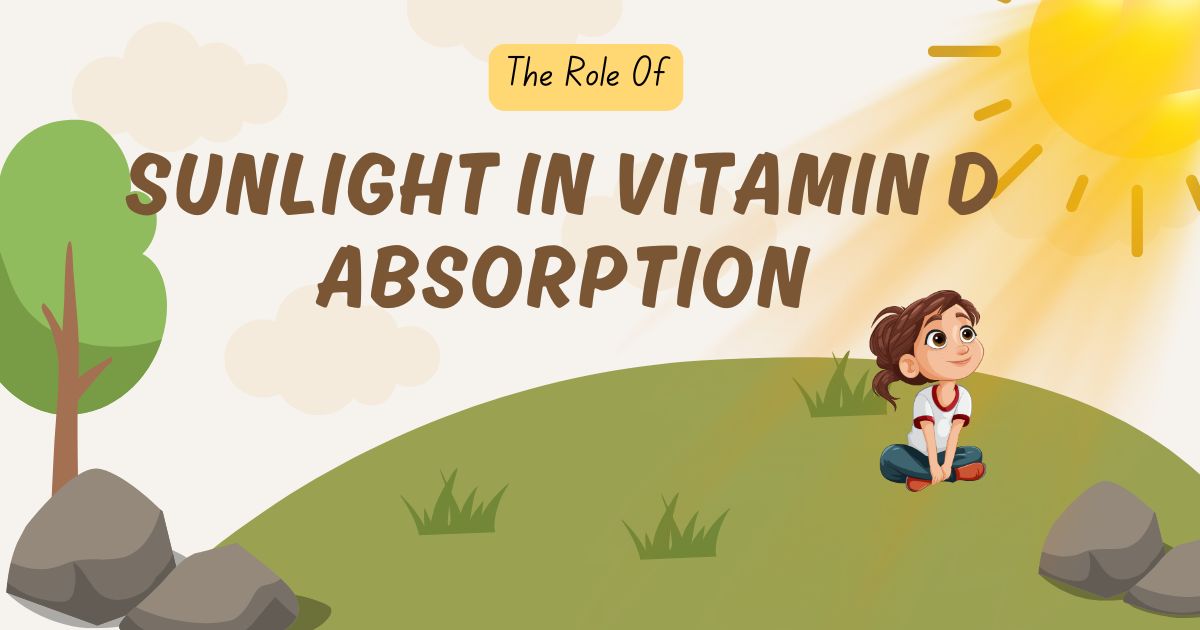Vitamin D, often called the “sunshine vitamin,” plays a crucial role in maintaining healthy bones, supporting the immune system, and regulating mood. Unlike other vitamins, our bodies can produce vitamin D naturally when exposed to sunlight. But how exactly does sunlight help with vitamin D absorption? Let’s dive into the science behind it, the benefits, and the best practices to ensure you’re getting enough of this vital nutrient.
What is Vitamin D?
Vitamin D is a fat-soluble vitamin that acts more like a hormone in the body. It helps regulate calcium and phosphorus, two minerals essential for strong bones and teeth. Without adequate vitamin D, bones can become brittle, leading to conditions like rickets in children and osteoporosis in adults.
There are two main types of vitamin D:
-
Vitamin D2 (ergocalciferol): Found in plant-based sources and supplements.
-
Vitamin D3 (cholecalciferol): Produced in the skin when exposed to sunlight and found in animal-based foods.
Among the two, Vitamin D3 is more effective at raising blood levels of vitamin D and is directly linked to sunlight exposure.
How Sunlight Helps in Vitamin D Absorption
When ultraviolet B (UVB) rays from the sun hit the skin, a chemical reaction takes place. The skin contains a compound called 7-dehydrocholesterol, which absorbs UVB radiation and converts it into previtamin D3. This compound is then transformed into vitamin D3, which the liver and kidneys further process into its active form, calcitriol.
This active form of vitamin D is what the body uses to regulate calcium absorption, bone health, immune function, and more.
The Best Time to Get Vitamin D from Sunlight
Not all sunlight is equal when it comes to vitamin D production. Factors such as time of day, season, location, and skin tone influence how much vitamin D your body produces.
-
Midday Sun (10 a.m. to 2 p.m.) is the most effective time, as UVB rays are strongest.
-
Summer months provide more UVB exposure compared to winter, especially in regions far from the equator.
-
People with darker skin may need more sun exposure because melanin reduces the skin’s ability to produce vitamin D.
-
Those living in northern latitudes may struggle to get enough UVB rays in winter, making supplementation or diet sources necessary.
On average, 10 to 30 minutes of sun exposure a few times a week is enough for most people, depending on skin type and environmental conditions.
Factors That Affect Vitamin D Synthesis from Sunlight
Several factors can influence how much vitamin D you get from sunlight:
-
Skin Color – People with higher melanin need longer exposure to produce the same vitamin D levels as those with lighter skin.
-
Age – As we age, our skin becomes less efficient at producing vitamin D.
-
Sunscreen Use – While sunscreen protects against skin cancer, it can also block UVB rays, reducing vitamin D synthesis.
-
Clothing and Lifestyle – People who cover most of their skin or spend little time outdoors are at higher risk of deficiency.
-
Geographic Location – Living closer to the equator provides more consistent year-round UVB exposure.
Health Benefits of Vitamin D from Sunlight
Getting enough vitamin D from sunlight has several proven health benefits backed by science:
1. Stronger Bones and Teeth
Vitamin D helps the body absorb calcium, ensuring bone density and strength. Without it, bones can weaken, increasing the risk of fractures.
2. Improved Immune System
Vitamin D supports the immune system, helping the body fight infections and reducing the risk of autoimmune diseases.
3. Better Mood and Mental Health
Research links vitamin D deficiency with depression, seasonal affective disorder (SAD), and anxiety. Sunlight exposure helps regulate mood by influencing serotonin levels.
4. Reduced Risk of Chronic Diseases
Adequate vitamin D levels may lower the risk of heart disease, type 2 diabetes, and certain cancers.
5. Enhanced Muscle Function
Vitamin D helps muscles contract properly, reducing the risk of falls in older adults.
Risks of Too Much Sun Exposure
While sunlight is essential for vitamin D, excessive exposure can be harmful. Overexposure to UV rays increases the risk of:
-
Skin cancer (melanoma and non-melanoma types)
-
Skin aging (wrinkles, dark spots, and sagging)
-
Eye damage (cataracts and macular degeneration)
To balance safety and vitamin D absorption, it’s best to get moderate sun exposure without burning and use protective measures like hats, sunglasses, and sunscreen when spending extended periods outdoors.
Alternative Sources of Vitamin D
If sunlight exposure is limited, you can still maintain healthy vitamin D levels through diet and supplements.
Food Sources of Vitamin D:
-
Fatty fish (salmon, tuna, mackerel, sardines)
-
Egg yolks
-
Fortified foods (milk, orange juice, cereals)
-
Cod liver oil
Supplements:
Vitamin D supplements are widely available and often recommended for individuals at risk of deficiency. Vitamin D3 supplements are more effective than D2 for maintaining optimal levels.
Recommended Daily Intake of Vitamin D
The recommended intake varies by age, health status, and lifestyle. According to health authorities:
-
Infants (0–12 months): 400 IU (10 mcg)
-
Children & Adults (1–70 years): 600 IU (15 mcg)
-
Adults over 70 years: 800 IU (20 mcg)
-
Pregnant & breastfeeding women: 600 IU (15 mcg)
Conclusion
The role of sunlight in vitamin D absorption is undeniable. Sunlight provides a natural, free, and effective way to maintain healthy vitamin D levels, which are essential for strong bones, a robust immune system, and overall well-being. However, balance is key—too much sun increases the risk of skin damage, while too little leads to vitamin D deficiency. By combining safe sun exposure, a vitamin D-rich diet, and supplements if needed, you can enjoy the full benefits of this sunshine vitamin for a healthier life.
Also Read : How Drinking Enough Water Boosts Your Energy Levels
FAQs
1. How long should I stay in the sun for vitamin D?
Around 10–30 minutes, several times per week, is enough for most people. However, this varies by skin tone, age, and location.
2. Can I get vitamin D through a window?
No. Glass blocks UVB rays, so your body cannot produce vitamin D indoors behind a window.
3. Is early morning sunlight good for vitamin D?
Early morning sunlight has lower UVB levels, making it less effective for vitamin D production compared to midday sun.
4. Do darker-skinned people need more sun exposure?
Yes, higher melanin levels mean darker-skinned individuals need longer sun exposure to produce the same amount of vitamin D.
5. Should I take supplements if I don’t get enough sun?
Yes. If you live in regions with limited sunlight or spend little time outdoors, supplements can help prevent deficiency.Conclusion



